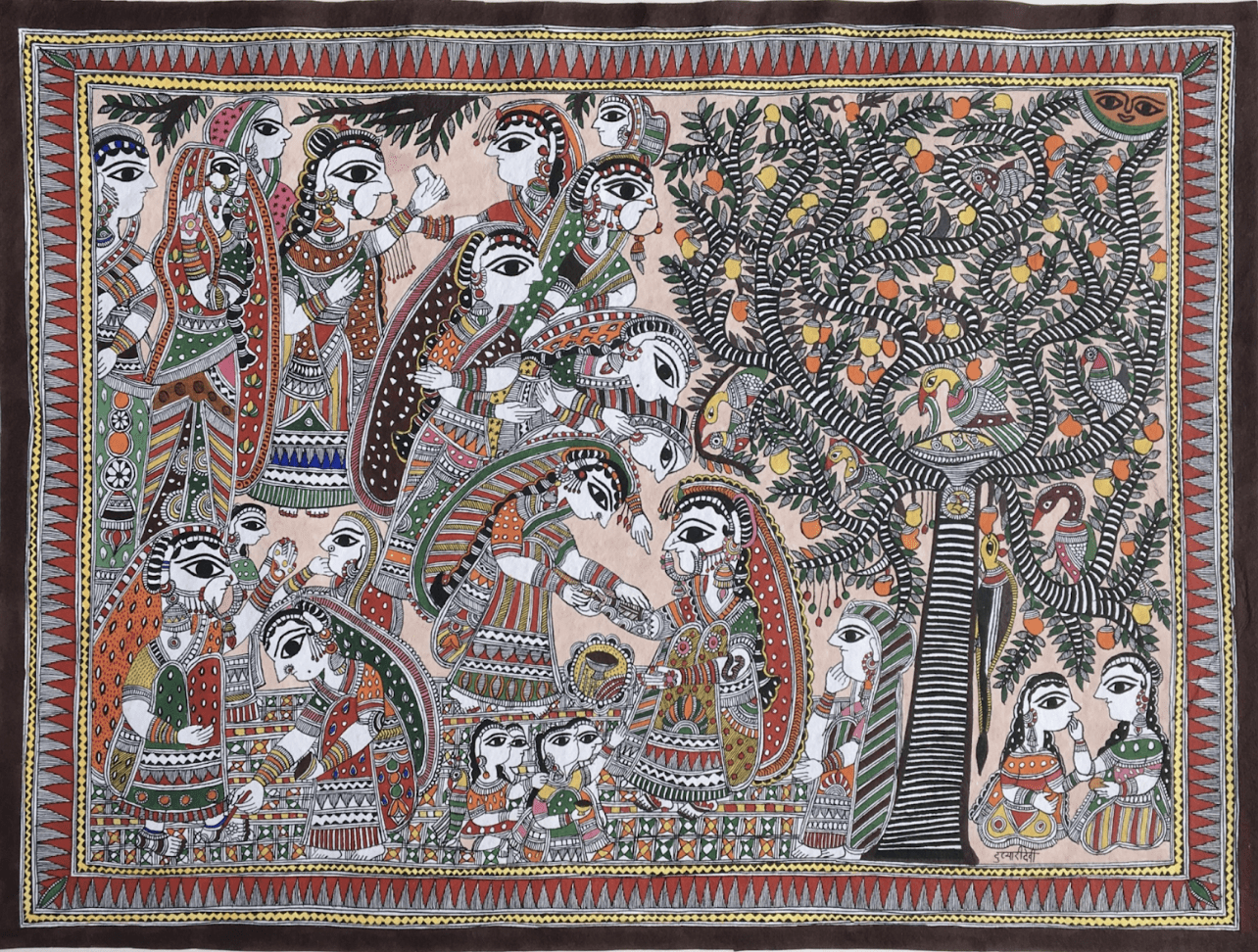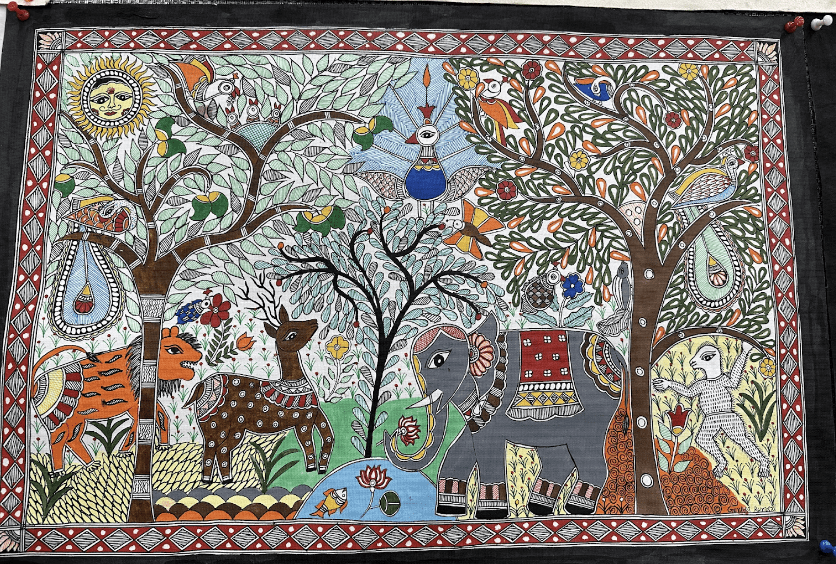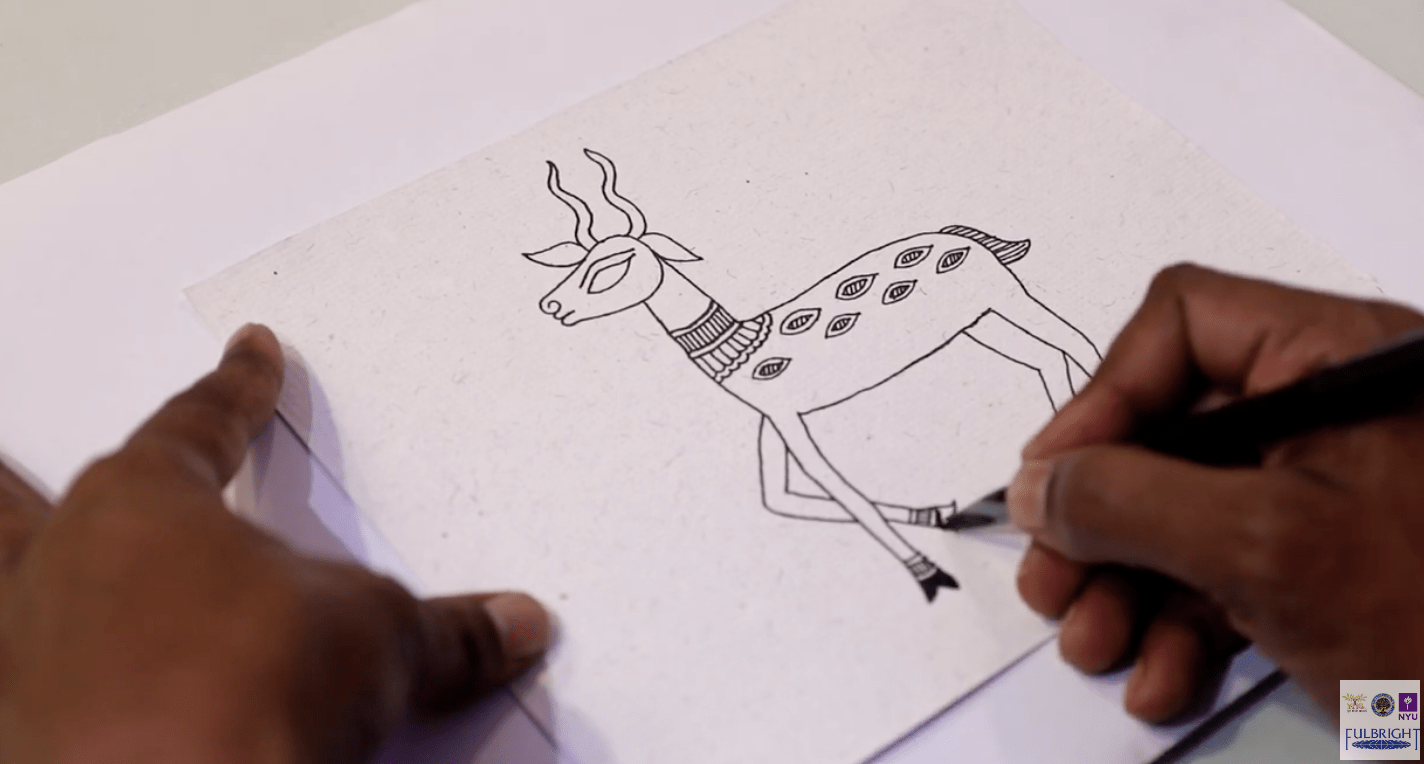Developed by Neena Sarin
A Traditional Folk Art from Mithila
“Marriage Preparations” by Dulari Devi
Photo Credit Link
Time: 2 X 75 Minutes
Proficiency Level: Intermediate Range
The Essential Question: What symbols and patterns are present in Madhubani art? How can we use its bright colors and designs to share stories about our lives and cultures?
Enduring Understanding: Through exploring Madhubani art, students will develop an appreciation for folk art from diverse cultures, fostering a sense of Interconnectedness and global citizenship. Additionally, they will understand how art can be a powerful communication tool that fosters connections between people from different backgrounds.
Unit Objectives: By the end of the unit, the students will be able to:
- Identify and explain Madhubani art as well as its historical and cultural context.
- Understand and summarise the main ideas in a painting
- Describe in detail what narrative is depicted in a Madhubani painting.
- Ask and answer questions about the basic techniques and motifs used in Madhubani art, such as animals, plants, geometric patterns, and mythological figures.
- Explore and follow instructions to practice the traditional techniques used in Madhubani art, including outlining, drawing patterns and shapes, and filling with watercolor paints.
- Create their own Madhubani-inspired artwork based on a personal story or memory about nature.
- Expand their Hindi vocabulary by learning art-related terms and Madhubani art-specific terminology.
Language Targets:
- a) related to the drawing practice:
— imperative vs. subjunctive — tum khiincho / aap khiinchiye vs. aap khiincheN
— obligatory construction: kyaa karnaa chaahiye/hogaa/paRegaa;
(b) related to story-telling activity:
– perfect tense and the ergative construction: vah gaya/gayii/gaye vs. usne hiran dekhaa
— relative correlative sentences: jab… tab…; jo… vah…
– passive voice: kiyaa jaataa hai / banaayaa jaataa hai / dekhaa jaataa hai
For example: Madhubanii chitrakaarii meN aam taur bahut saare rangon kaa prayog kiyaa jaataa hai. Par kayii chitroN meN keval laal aur safed rang hii hote haiN. Hamne dekhaa hai ki log lok kathaayon se yaa lok giitoN se bhi chitroN ke vishay chunte haiN.
Performance Task: Imagine you are an artist at a workshop. Your task is to create a painting or artwork on paper or canvas using the Madhubani style and present it to the community members at an Art Fair. Discuss the specific elements of the Madhubani style you incorporated in your painting, the composition, and the narrative. You are encouraged to draw from your personal story or memory. Ensure that the newly acquired vocabulary words (10+) and new language structures (6+) are incorporated when speaking and writing. For extra credit, write a paragraph of six to eight sentences reflecting on your experience exploring Madhubani art and Indian culture.
Vocabulary:
Nature/Animal/Birds
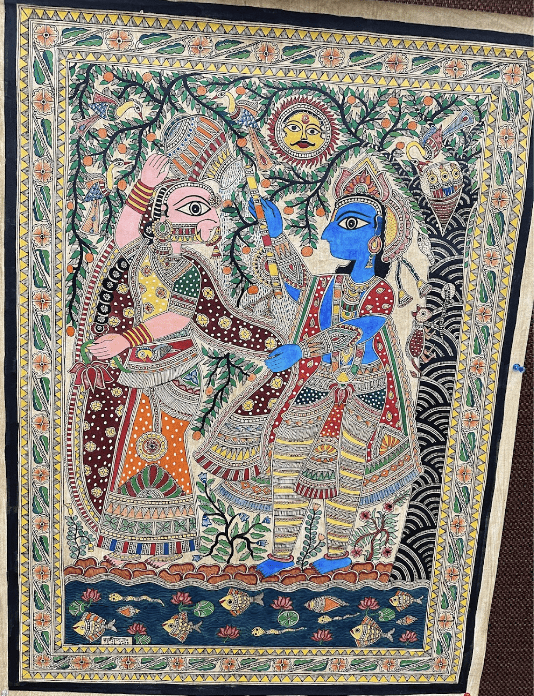
- पेड़ m. (peR) – tree
- पत्ता m. (pattaa) – leaf
- फूल m. (phuul) – flower
- कमल m. (kamal)-lotus
- घास m. (ghaas) – grass
- बारिश f. (baarish) – rain
- बादल m. (baadal) or मेघ m. (megh in poetry) – cloud
- धरती f. (dhartii) – earth
- पानी m. (paanii) – water
- नदी f. (nadii) – river
- झील f. (jhiil) – lake
- पक्षी m. (pakshi) – bird
- मछली f. (machhli) – fish
- मोर m. (mor) – peacock
- कछुआ m. (kachhuaa) – tortoise
- हाथी m. (haathi) – elephant
- गाय f. (gaay) – cow
- तोता m. (totaa) -parrot
- गौरैया m. (gauraiyaa) – sparrow
- सांप m. (saaMp) – snake
- मगरमच्छ m. (magarmachch) – crocodile
- बाघ m. ( bagh) – tiger
- सूर्यm. (surya) – sun
- चाँद m. (chaand) – moon
Religion/Mythology/Symbols/Madhubani Art
- लोक कला f. (lok kalaa) – folk art
- प्राकृतिक रंग (praakritik rang) – natural dyes
- कहानी सुनाना (kahaanii sunaana) – story telling
- कृष्ण (Krishna) – Krishna – The avatar of Lord Vishnu
- राधा (Raadhaa) – Radha – beloved of lord Krishna
- राम (Rama) – Rama – The avatar of Lord Vishnu
- सीता (Sita) – Sita – The wife of lord Rama
- गणेश (GaNesha) – Ganesha -The elephant-headed deity, son of Shiva and Parvati
- शिव (Shiva) – Shiva – The god of destruction
- पार्वती (Paarvati) – Parvati- The wife of lord Shiva
- गंगा (gangaa) – sacred river
- बिंदु m. (bindu) – dot
- रेखा f. (rekhaa) – line
- लहरिया f. (lahriyaa) – curved line
- कचनी f. (kachnii) – finer lines and intricate pattern
Lesson 1: Immerse into the Beautiful World of Madhubani Art
Learning Episode 1: Building the Background
The teacher presents a series of pictures to the students, showcasing various folk art forms worldwide. The teacher explains that folk art is a traditional art form created by people without formal training and passed down through generations. Folk art forms are usually associated with a particular community or culture. The teacher then discusses Madhubani folk art and explains that Madhubani art originated in the Mithila region of India and has been passed down through generations. The teacher shows the video of the Madhubani railway station (time stamp 0.09-1:20) and points out the artwork on the station’s walls. The teacher will have the students share their thoughts on the art and how it made the railway station different from the others. The teacher supports the students’ answers by scaffolding and introducing the new vocabulary words in context. The teacher writes the vocabulary words on a whiteboard.
Learning Episode 2: Mithila Region and Madhubani Art
To help students better understand, the teacher shows the map of India and points out the Mithila region between the lower Himalayas and the Ganges River. The area is between South Nepal and North India, specifically the Madhubani in Bihar, India. The Mithila region is also known because it was the birthplace of Sita during the epic Ramayana (post the Mithia history video on Google Classroom for an additional independent-level/HW activity). Using the smart board, the teacher displays pictures of Madhubani art and has the students answer what they see in the paintings. The teacher continuously supports the new vocabulary words in context. The teacher lists the vocabulary words on the board.
Learning Episode 3: Motifs, Patterns, and Themes in Madhubani Paintings
The teacher posts the Mithila Chitrakari Madhubani art photos in the Google Classroom. The students work in small groups and make a list of the motifs, themes, and patterns they see in the Madhubani paintings. The teacher supports them in identifying the themes from Indian mythology/folk songs).
Learning Episode 4: Understanding the Basic Elements of Madhubani Paintings
The students share their observations/lists of what they see in Madhubani paintings. The teacher categorizes the list as Natural elements/ themes from folk stories/folk songs/Indian mythology and other elements, such as geometrical shapes, borders, lines, patterns, and Kacnni. Traditionally, the artists used natural dyes only. The teacher shows a video of famous Madhubani painting artists (6:24-8:39)showing these features. The teacher and students discuss the features/elements of Madhubani paintings as they go through the slide show again in a group setting to explore the main idea and details in the paintings.
Extended Activity: The teacher will give the students additional reading materials and terminology for Madhubani paintings for homework.
Lesson 2: Creating a Madhubani Art Inspired Artwork
- Paper
- Pencils
- Watercolor paints
- Paint brushes
- Black markers
- Reference images of Madhubani art
Learning Episode 1: Guided Practice 1
The teacher will review what the students learned about Madhubani art paintings. The students will then use their notes to discuss the basic elements of Madhubani paintings.
The teacher and students will watch a video (6:24-8:39) about the basics of Madhubani art and practice drawing the lines, borders, dots, etc. they see on paper. The students will then watch the artists draw an elephant and a peacock (8:46-13:05) and practice drawing a border, an elephant, and a peacock. The teacher will pause the video when needed. 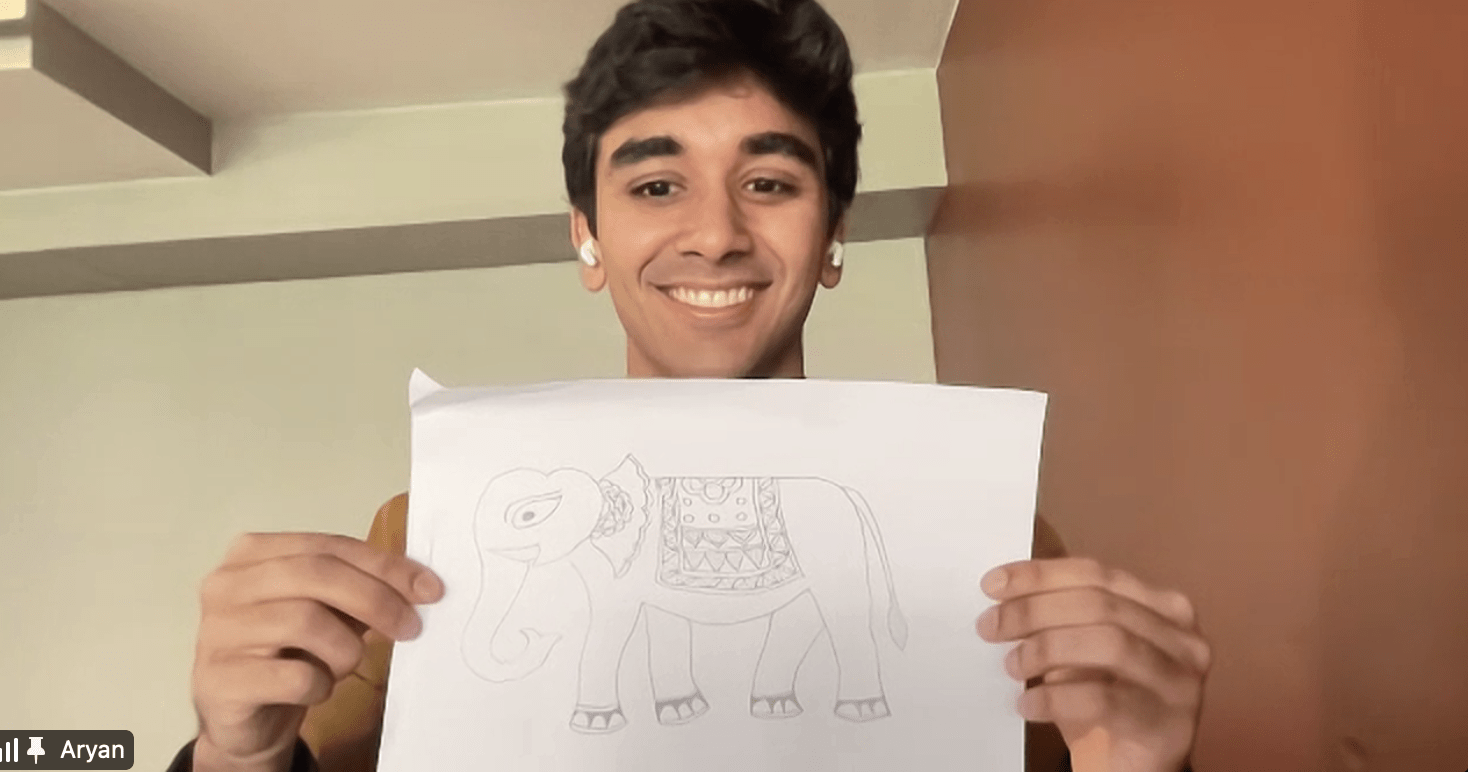
13:52 and video link (3:56-4:06)(4:42-5:17)
Learning Episode 2: Step-by-Step Guided Practice
The students will then watch the Pratik Prabhakar Workshop video for step-by-step directions on drawing an elephant and a deer in the Madhubani art style. They will follow the directions and work on their drawings. When they are done, the teacher will encourage the students to draw a border using the Madhubani paintings as a reference and color their artwork.
Learning Episode 3: Artwork Ideas
The students will work in small groups and discuss the theme, story, or memory they want to draw in the Madhubani art style. They will take feedback from their peers and select the theme for their artwork, using the conventions of Madhubani art paintings.
Learning Episode 4: Creating Madhubani Inspired Artwork
The students begin working on their Madhubani-inspired artwork. They complete their artwork as homework and present it to the class. Encourage the students to use the self-evaluation rubric.
Extended Activities: The teacher will encourage the students to share their feelings when working on the Madhubani art-inspired artworks. The teacher will lead the discussion on how art can be a practice for mindfulness.
The teacher will have the students research the famous Mithila art artists and make a list of them. The students will share their possible findings. (Women have been practicing the traditional practices of Madhubani art since the beginning. The most famous artists today are also women). The research will connect to the next unit plan, “ The Super heroines of Mithila.”
